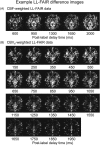Coupling between cerebral blood flow and cerebral blood volume: Contributions of different vascular compartments
- PMID: 30657208
- PMCID: PMC6492110
- DOI: 10.1002/nbm.4061
Coupling between cerebral blood flow and cerebral blood volume: Contributions of different vascular compartments
Abstract
A better understanding of the coupling between changes in cerebral blood flow (CBF) and cerebral blood volume (CBV) is vital for furthering our understanding of the BOLD response. The aim of this study was to measure CBF-CBV coupling in different vascular compartments during neural activation. Three haemodynamic parameters were measured during a visual stimulus. Look-Locker flow-sensitive alternating inversion recovery was used to measure changes in CBF and arterial CBV (CBVa ) using sequence parameters optimized for each contrast. Changes in total CBV (CBVtot ) were measured using a gadolinium-based contrast agent technique. Haemodynamic changes were extracted from a region of interest based on voxels that were activated in the CBF experiments. The CBF-CBVtot coupling constant αtot was measured as 0.16 ± 0.14 and the CBF-CBVa coupling constant αa was measured as 0.65 ± 0.24. Using a two-compartment model of the vasculature (arterial and venous), the change in venous CBV (CBVv ) was predicted for an assumed value of baseline arterial and venous blood volume. These results will enhance the accuracy and reliability of applications that rely on models of the BOLD response, such as calibrated BOLD.
Keywords: BOLD; CBF-CBV coupling; arterial spin labelling; cerebral blood volume; fMRI.
© 2019 The Authors. NMR in Biomedicine published by John Wiley & Sons Ltd.
Figures




Similar articles
-
Cortical layer-dependent dynamic blood oxygenation, cerebral blood flow and cerebral blood volume responses during visual stimulation.Neuroimage. 2008 Oct 15;43(1):1-9. doi: 10.1016/j.neuroimage.2008.06.029. Epub 2008 Jul 4. Neuroimage. 2008. PMID: 18655837 Free PMC article.
-
The absolute CBF response to activation is preserved during elevated perfusion: Implications for neurovascular coupling measures.Neuroimage. 2016 Jan 15;125:198-207. doi: 10.1016/j.neuroimage.2015.10.023. Epub 2015 Oct 23. Neuroimage. 2016. PMID: 26477657 Free PMC article.
-
Non-BOLD contrast for laminar fMRI in humans: CBF, CBV, and CMRO2.Neuroimage. 2019 Aug 15;197:742-760. doi: 10.1016/j.neuroimage.2017.07.041. Epub 2017 Jul 20. Neuroimage. 2019. PMID: 28736310 Review.
-
A theoretical framework for estimating cerebral oxygen metabolism changes using the calibrated-BOLD method: modeling the effects of blood volume distribution, hematocrit, oxygen extraction fraction, and tissue signal properties on the BOLD signal.Neuroimage. 2011 Sep 1;58(1):198-212. doi: 10.1016/j.neuroimage.2011.05.077. Epub 2011 Jun 6. Neuroimage. 2011. PMID: 21669292 Free PMC article.
-
Noise concerns and post-processing procedures in cerebral blood flow (CBF) and cerebral blood volume (CBV) functional magnetic resonance imaging.Neuroimage. 2017 Jul 1;154:43-58. doi: 10.1016/j.neuroimage.2016.09.007. Epub 2016 Sep 11. Neuroimage. 2017. PMID: 27622397 Free PMC article. Review.
Cited by
-
Most Small Cerebral Cortical Veins Demonstrate Significant Flow Pulsatility: A Human Phase Contrast MRI Study at 7T.Front Neurosci. 2020 May 5;14:415. doi: 10.3389/fnins.2020.00415. eCollection 2020. Front Neurosci. 2020. PMID: 32431591 Free PMC article.
-
Total cerebral blood volume changes drive macroscopic cerebrospinal fluid flux in humans.PLoS Biol. 2025 Apr 24;23(4):e3003138. doi: 10.1371/journal.pbio.3003138. eCollection 2025 Apr. PLoS Biol. 2025. PMID: 40273212 Free PMC article.
-
Hemodynamic and metabolic correspondence of resting-state voxel-based physiological metrics in healthy adults.Neuroimage. 2022 Apr 15;250:118923. doi: 10.1016/j.neuroimage.2022.118923. Epub 2022 Jan 20. Neuroimage. 2022. PMID: 35066157 Free PMC article.
-
Multiparametric Brain Hemodynamics Imaging Using a Combined Ultrafast Ultrasound and Photoacoustic System.Adv Sci (Weinh). 2024 Aug;11(31):e2401467. doi: 10.1002/advs.202401467. Epub 2024 Jun 17. Adv Sci (Weinh). 2024. PMID: 38884161 Free PMC article.
-
Cerebral and systemic physiological effects of wearing face masks in young adults.Proc Natl Acad Sci U S A. 2021 Oct 12;118(41):e2109111118. doi: 10.1073/pnas.2109111118. Proc Natl Acad Sci U S A. 2021. PMID: 34607955 Free PMC article.
References
-
- Hoge RD, Atkinson J, Gill B, Crelier GR, Marrett S, Pike GB. Investigation of BOLD signal dependence on cerebral blood flow and oxygen consumption: the deoxyhemoglobin dilution model. Magn Reson Med. 1999;42:849‐863. - PubMed
-
- Buxton RB, Wong EC, Frank LR. Dynamics of blood flow and oxygenation changes during brain activation: the balloon model. Magn Reson Med. 1998;39:855‐864. - PubMed
-
- Grubb RL, Raichle ME, Eichling JO, Ter‐Pogossian MM. The effects of changes in PaCO2 on cerebral blood volume, blood flow, and vascular mean transit time. Stroke. 1974;5:630‐639. - PubMed
Publication types
MeSH terms
Grants and funding
LinkOut - more resources
Full Text Sources

